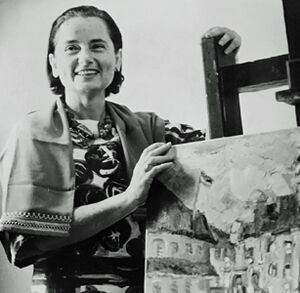Suzanne Perlman facts for kids
Quick facts for kids
Suzanne Perlman
|
|
|---|---|
 |
|
| Born |
Suzanne Sternberg
18 October 1922 Budapest, Hungary
|
| Died | 2 August 2020 (aged 97) London, England
|
| Nationality | Hungarian Dutch |
| Known for | Painting |
| Movement | Expressionism |
| Awards | Order of Orange-Nassau |
Suzanne Perlman (born October 18, 1922 – died August 2, 2020) was a talented artist from Hungary and the Netherlands. She was famous for her unique style of painting called Expressionism. She painted many portraits and landscapes.
Suzanne Perlman used bright, bold colors in her art. This started when she painted the tropical island of Curaçao. She moved there with her husband in 1940 to find safety during a difficult time in Europe. Her special expressionist style grew even more when she learned from a famous Austrian artist, Oskar Kokoschka, in the 1950s and 1960s. An art critic once said that her paintings "capture the feeling of a place" while still showing her exciting expressionist touch.
Suzanne studied art at several well-known schools. These included Columbia University School of the Arts, Instituto Allende, and Saint Martin's School of Art.
Contents
Suzanne Perlman's Life and Art
Her Early Life and Escape
Suzanne Perlman was born in Budapest, Hungary, in October 1922. Her birth name was Suzanne Sternberg. She grew up in a Jewish family with her brother, Sigmund Sternberg, and her parents, Abraham and Elisabeth. Her family owned an art and antiques shop. Her father, Abraham, loved art and helped many young Hungarian artists.
Suzanne's early art training came from helping her parents. She would sort and organize postcards of famous artworks. She saw this as her first real art lesson. She left school at 13 after her father passed away.
In 1939, when she was 17, Suzanne married Heinz Perlman, a businessman. They moved to Rotterdam, Holland. Soon, Europe became a dangerous place. A sudden trip to Paris for Heinz's business saved their lives. They arrived in Paris just before Rotterdam was bombed in May 1940. Suzanne said her husband's office building was one of the first places hit. Amidst the confusion, they managed to get on the last ship leaving Europe. In August 1940, they arrived safely in Curaçao.
Art in Curaçao
When Suzanne arrived in Curaçao, she couldn't speak Papiamento, the local language. So, she used her art to show how much she loved the island and its people. She often painted everyday scenes. She showed street vendors, people playing dominoes, and traditional dancers.
For some years, she and her husband ran an antiques business. Her art studio was in the attic above the shop. Suzanne had her first big solo art show at the Curaçao Museum in 1961.
In the 1960s, while living in Curaçao, Suzanne was chosen for a special art workshop. It was led by Oskar Kokoschka in Salzburg, Austria. After the workshop, she was invited to work with him in his studio. This experience greatly influenced her art and helped her develop her expressionist style. Suzanne remembered Kokoschka telling her, "Technique you can learn, but the moment of vision cannot be taught."
New York Art Scene
From the early 1950s, Suzanne and Heinz lived in New York City. Suzanne continued her art studies there. She attended the Art Students League of New York starting in 1955.
During this time, New York was a hub for a new art style called abstract expressionism. In 1950, Suzanne painted her first known abstract expressionist work. Later, she studied with painter Sidney Gross. She found inspiration from him and created abstract paintings. These works still had the bright, lively colors she remembered from the Caribbean islands.
London's Influence
After her husband passed away in 1983, Suzanne moved to London in the 1980s. She wanted to be closer to her family. Moving to London brought new life to her art. She said, "I began to paint immediately." As someone new to the city, she felt a sense of wonder about what she saw. She wanted to share this feeling through her paintings.
In 2014, an exhibition called Suzanne Perlman, Painting London was held at the Ben Uri Gallery. The curator, David Glasser, described her London paintings. He said they showed a mix of nature, city life, dreams, and real events. Her art included summer parties in parks, busy streets, nightlife in Covent Garden, and famous buildings like the Houses of Parliament.
In 2018, Suzanne had her first big show in London that looked back at her whole career. It was at the Dutch Centre. An art critic from the Financial Times called her work "expressive, visionary, and deeply connected to modern art."
Art in Collections
Suzanne Perlman's artworks are kept in many important museum collections around the world. These include:
- Rijksmuseum, Amsterdam
- Stedelijk Museum, Amsterdam
- Curaçao Museum
- Parliamentary Art Collection (House of Lords)
- Ben Uri Gallery, London
- Museum of London
- Dohány Street Synagogue (Jewish Museum of Budapest)
- Jewish Museum London
- Joods Historisch Museum, Amsterdam
- Museum Gouda, Holland
- Ruth Borchard Collection
- Queen Beatrix, the Queen Mother, Netherlands Royal Collection
- El Museo del Barrio, New York

